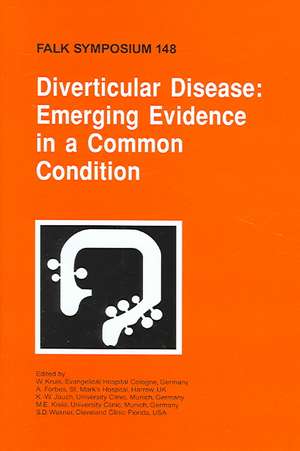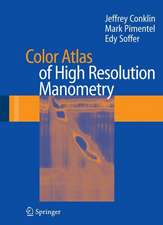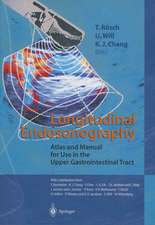Diverticular Disease: Emerging Evidence in a Common Condition: Falk Symposium, cartea 148
Editat de W. Kruis, A. Forbes, K. -W Jauch, M. E. Kreis, S.D. Wexneren Limba Engleză Hardback – 23 feb 2006
An approach to diverticular disease that is generally accepted is lacking. One reason may be that there is a certain paucity of scientific discussion. In contrast to other topics, diverticular disease is rarely found on the agenda of meetings and symposia.
The book, the proceedings of Falk Symposium 148 on Diverticular Disease: Emerging Evidence in a Common Condition, held in Munich, Germany, on 17–18 June 2005, covers many aspects of diverticular disease, from new scientific knowledge to exchange of clinical experience, and will provide much-needed information to basic scientists and clinicians alike.
Din seria Falk Symposium
- 5%
 Preț: 1425.04 lei
Preț: 1425.04 lei - 5%
 Preț: 1092.06 lei
Preț: 1092.06 lei - 5%
 Preț: 1415.16 lei
Preț: 1415.16 lei - 5%
 Preț: 1419.56 lei
Preț: 1419.56 lei - 5%
 Preț: 1421.57 lei
Preț: 1421.57 lei - 5%
 Preț: 1418.68 lei
Preț: 1418.68 lei - 5%
 Preț: 1415.16 lei
Preț: 1415.16 lei - 5%
 Preț: 2124.15 lei
Preț: 2124.15 lei - 5%
 Preț: 1105.04 lei
Preț: 1105.04 lei - 5%
 Preț: 1103.95 lei
Preț: 1103.95 lei - 5%
 Preț: 2138.98 lei
Preț: 2138.98 lei - 5%
 Preț: 1108.72 lei
Preț: 1108.72 lei - 5%
 Preț: 1100.85 lei
Preț: 1100.85 lei - 5%
 Preț: 1105.40 lei
Preț: 1105.40 lei - 5%
 Preț: 716.28 lei
Preț: 716.28 lei - 5%
 Preț: 1101.21 lei
Preț: 1101.21 lei - 5%
 Preț: 1106.86 lei
Preț: 1106.86 lei - 5%
 Preț: 717.00 lei
Preț: 717.00 lei - 5%
 Preț: 1099.73 lei
Preț: 1099.73 lei - 5%
 Preț: 1100.09 lei
Preț: 1100.09 lei - 5%
 Preț: 1104.84 lei
Preț: 1104.84 lei - 5%
 Preț: 1422.31 lei
Preț: 1422.31 lei - 5%
 Preț: 1093.88 lei
Preț: 1093.88 lei - 5%
 Preț: 1105.77 lei
Preț: 1105.77 lei - 5%
 Preț: 1106.50 lei
Preț: 1106.50 lei - 5%
 Preț: 1094.44 lei
Preț: 1094.44 lei - 5%
 Preț: 1100.09 lei
Preț: 1100.09 lei - 5%
 Preț: 997.40 lei
Preț: 997.40 lei - 5%
 Preț: 996.07 lei
Preț: 996.07 lei - 5%
 Preț: 2111.16 lei
Preț: 2111.16 lei - 5%
 Preț: 1098.99 lei
Preț: 1098.99 lei - 5%
 Preț: 1099.94 lei
Preț: 1099.94 lei - 5%
 Preț: 1096.62 lei
Preț: 1096.62 lei - 5%
 Preț: 1411.54 lei
Preț: 1411.54 lei - 5%
 Preț: 1098.12 lei
Preț: 1098.12 lei - 5%
 Preț: 1415.16 lei
Preț: 1415.16 lei - 5%
 Preț: 1407.51 lei
Preț: 1407.51 lei - 5%
 Preț: 2112.10 lei
Preț: 2112.10 lei - 5%
 Preț: 2117.20 lei
Preț: 2117.20 lei - 5%
 Preț: 1423.58 lei
Preț: 1423.58 lei - 5%
 Preț: 1098.99 lei
Preț: 1098.99 lei - 5%
 Preț: 714.06 lei
Preț: 714.06 lei - 5%
 Preț: 1098.48 lei
Preț: 1098.48 lei - 5%
 Preț: 1101.21 lei
Preț: 1101.21 lei - 5%
 Preț: 1418.83 lei
Preț: 1418.83 lei - 5%
 Preț: 1913.14 lei
Preț: 1913.14 lei - 5%
 Preț: 1411.17 lei
Preț: 1411.17 lei - 5%
 Preț: 1794.27 lei
Preț: 1794.27 lei
Preț: 1098.84 lei
Preț vechi: 1156.67 lei
-5% Nou
Puncte Express: 1648
Preț estimativ în valută:
210.29€ • 218.73$ • 173.61£
210.29€ • 218.73$ • 173.61£
Carte tipărită la comandă
Livrare economică 14-28 aprilie
Preluare comenzi: 021 569.72.76
Specificații
ISBN-13: 9781402043178
ISBN-10: 1402043171
Pagini: 230
Ilustrații: XIII, 230 p.
Dimensiuni: 155 x 235 x 16 mm
Greutate: 0.53 kg
Ediția:2006
Editura: SPRINGER NETHERLANDS
Colecția Springer
Seria Falk Symposium
Locul publicării:Dordrecht, Netherlands
ISBN-10: 1402043171
Pagini: 230
Ilustrații: XIII, 230 p.
Dimensiuni: 155 x 235 x 16 mm
Greutate: 0.53 kg
Ediția:2006
Editura: SPRINGER NETHERLANDS
Colecția Springer
Seria Falk Symposium
Locul publicării:Dordrecht, Netherlands
Public țintă
Professional/practitionerCuprins
Pathogenesis of diverticular disease.- Patterns of colonic mucosal inflammation in diverticular disease.- Pathogenesis of diverticular disease: enteric neuropathy.- Pathogenesis of diverticular disease: altered motility.- Pathogenesis of diverticular disease: genetic disposition versus the environment.- Clinical issues.- Diverticular disease — differential diagnosis and prognosis.- Diagnosis I.- Diagnosis of diverticular disease in primary care.- Laboratory tests — what do they tell us?.- Lower gastrointestinal bleeding — search for sources.- Diagnosis II.- Intestinal comorbidity: diverticular disease and chronic inflammatory bowel disease.- Indications and controversies in imaging techniques.- Colonoscopy in acute diverticulitis.- Sonography in diverticular disease.- Diverticular disease: abdominal radiography, contrast enema, computed tomography, magnetic resonance imaging.- Determinants of treatment.- Natural course of diverticular disease.- Pain in diverticular diseases.- Determinants of treatment: extraintestinal comorbidity.- Determinants of treatment: outcome measures, or how to read studies on diverticulitis.- Surgery.- Extent of sigmoid resection in diverticular disease of the colon.- Surgery for diverticular disease: pro laparoscopy.- Medical treatment.- Medical management of diverticular disease: the role of bulking agents.- Antibiotics in the treatment of diverticular disease of the colon.- Aminosalicylates.- Treatment — miscellaneous.- Diverticular disease: persistent symptoms after surgery.- Primary and secondary prevention of diverticular disease.- The right time for medical or surgical treatment.
Caracteristici
Interdisciplinary symposium bringing together basic science and clinical applications Up-to-date research findings at the highest scientific level














